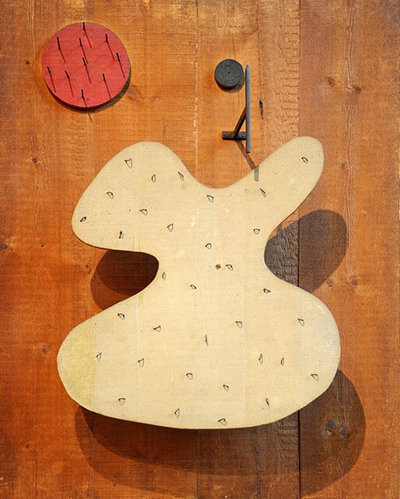Whilst we are familiar with the red sun delivered here by artist Miro, everything else is just a little different from his more common use of oils on canvas.
Construction is actually a combination of wooden and metallic elements, though the look is similar to many of his paintings. He put this piece together in 1930 and at this point in his career he released a number of wooden based artworks. In essence, his style was abstract art, with shapes and lines, but the medium in which they were delivered did not have to necessarily be oils. The items of wood that he used were entirely normal things that one might find lying around. He turned carpentry waste into an art form, through a careful consideration of how he could use it to construct his normal surrealist scenes of squares, circles and lines.
The canvas itself is wooden, perhaps a slice removed from a door or fence. The provides the neutral background on which he would then nail his objects. The red sun in the top left is held together by a series of grey nails, which are deliberately left visible. The main centre of the design is a creme coloured shape which remains some of the body of a guitar. There are beautiful curves, and again nails have been inserted to keep it in place. It is raised higher above the base than the others, sometimes giving a shadow, depending on the direction of the light. There are then additional elements above it, though these seem to be supporting elements that your eyes do not spot initially.
This creation is believed to be a part of the collection of MoMA in the US, and is a clear sign of an artist who was challenging traditional art, building a revolution, if you like. He found a number of like minded individuals within the Surrealist movement but Miro himself generally worked with more traditional mediums, though with a style that was entirely abstract by the end of his development.




